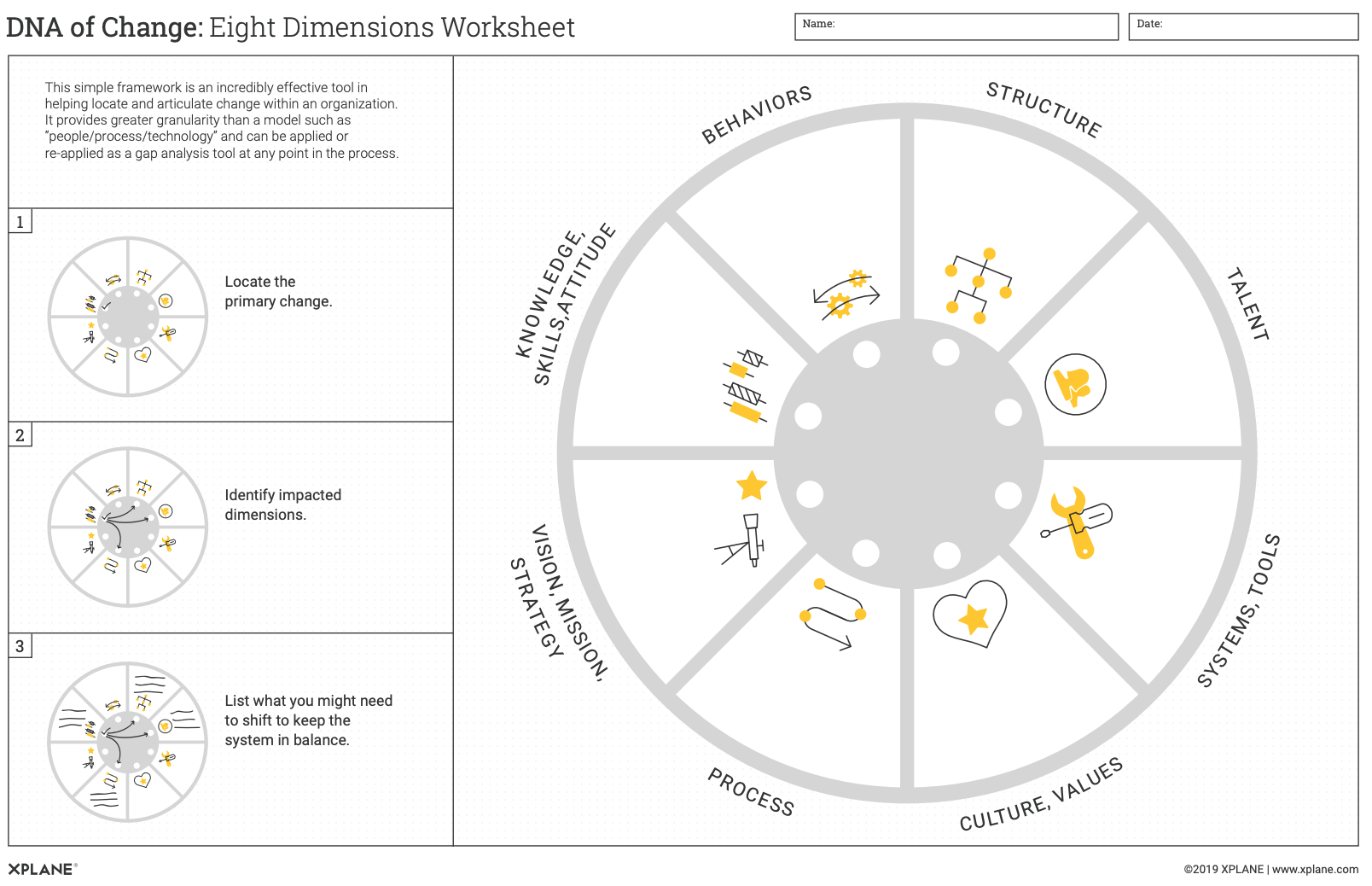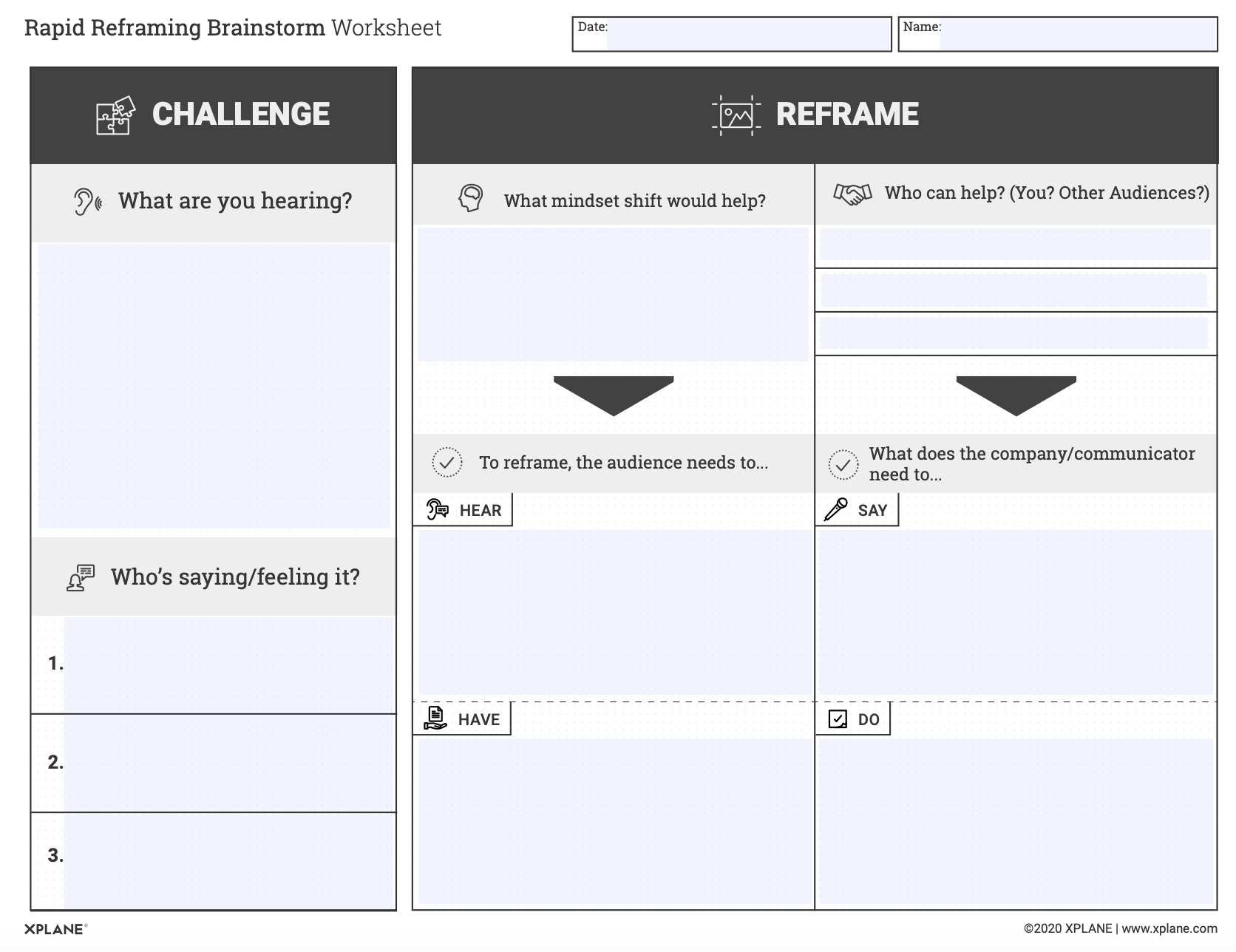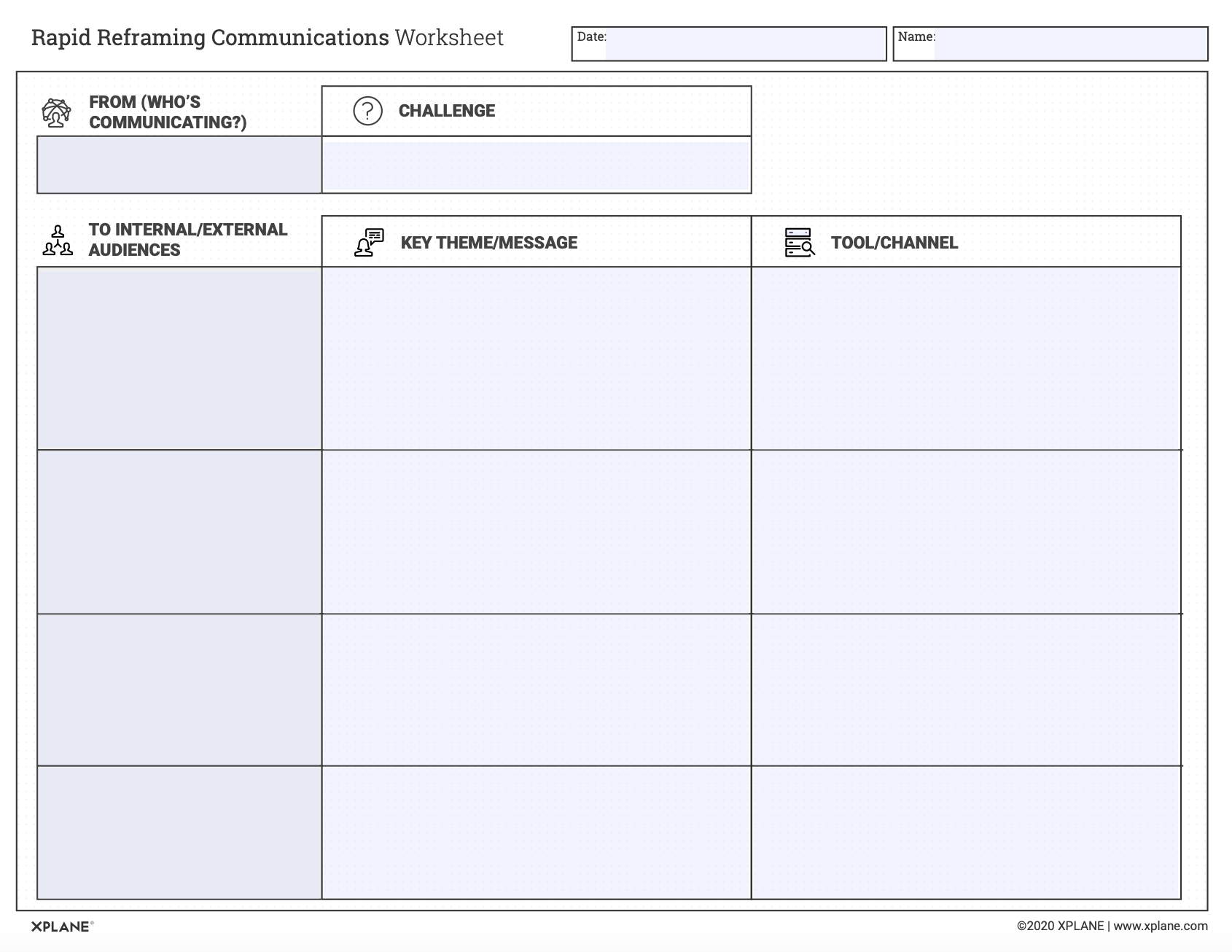This post is adapted from XPLANE’s webinar of the same name. For expanded content, you can view the webinar here.
Most of us have never experienced anything quite like the coronavirus pandemic.
The ways in which we work, connect, and communicate are being tested as they’ve never been tested before. Daily changes are affecting “business as usual” in unforeseen ways.
This won’t come as a surprise, but humans tend to not like change very much—even when it’s planned in advance.
So the onset of huge, unexpected changes like we’re experiencing now can create a lot of disturbance. It affects individuals at all levels of an organization. And eventually, it’s going to affect the organization itself.
The DNA of Change

XPLANE’s Eight Dimensions Worksheet illustrates the key components of an organization or business. When one component is thrown off balance, we need to make changes in other areas to rebalance.
The coronavirus crisis is pushing on several of these key areas at once. To some degree, it’s also pushing on behaviors people bring to organizations.
We need to help people get through this crisis and understand how they can help stabilize their organizations.
Begin with Empathy
Much of the work XPLANE does in human-centered design revolves around beginning any conversation with empathy.
And if there’s ever a time that we want to bring empathy to the forefront, it’s right now.
Everyone we interact with these days is experiencing something they’ve never experienced before. If we can, even for a moment, put ourselves in their shoes to understand their stresses, concerns, and sources of anxiety, then we’re going to help them weather this.
And if we can help them weather this, they are going to help our organizations survive.
Consider Your Audience
We next need to identify our audience(s) to understand their concerns.
In most organizations, we can group audiences together in relatively large buckets:
- Executive leadership
- People managers
- Staff
- Clients and customers
How do you organize information and communicate effectively with all these people in ways that address their unique needs?
Reframe the Situation
To accomplish this, XPLANE uses a proactive solution development process called rapid reframing.
With this process, you pull apart challenges by audience and put them back together in a communications plan that can be quickly understood and deployed by key leadership.
How does this work?
Let’s assume for now that you have developed or are already developing an organizational strategy for this challenging time.
Questions from your various audiences can probably be boiled down into four categories:
- Psychological well-being
- Organizational direction (strategy, mission, vision)
- Organizational structure and process
- Communication
The Rapid Reframing Brainstorm Worksheet

What are people hearing? As shown in the Rapid Reframing Brainstorm Worksheet, you’ll first want to identify what people are hearing and who is saying or feeling it.
- Pro tip: If you are working on the worksheet as a group, you might want to hear everyone out and then group similar thoughts together.
You’ll probably hear a lot of fear and uncertainty at this point.
So how do you respond? You do some reframing.
What do people need to hear? Boil the situation down to a current state and an ideal future state. For example, employees and clients want to move from anxiety (current state) to security (future state).
Then put yourself in their shoes. What would you want to hear and have to feel more secure?
Perhaps your employees and clients want to hear that the company is secure. They want a clear, succinct company stance and vision. They want to know where they fit in, and they want answers to their questions.
They might also want an action plan that includes them, regularly updated information, and a place to go for questions and help. Moreover, they want a sense that they are cared for by their organization.
Who can help? Next, determine who can help with communications. Communication rarely comes from one person or channel or just once. You’ll need help carrying a message and doing it consistently.
Executive leaders need to relay messages, for example, but people managers also need to know how to talk to their teams. Other staff might also be able to help communicate a message out to clients and customers.
How should you say it? In a situation such as we’re in today, clear, consistent, timely, and succinct messaging works best.
Messaging should consider tone, messenger, as well as what the audience needs to hear, both factually and psychologically to trust you—because this is now about trust.
Your communicator may want to convey that the organization is solid, what you’re doing to be proactive, how people can help, and share that you’re all in this together.
Where should you say it? You’ll want to identify your communication approach or vehicle—perhaps an FAQ document or a CEO memo—for both internal and external audiences. You’ll also want to select communications channels for updates.
- Pro Tip: During a crisis or period of rapid change, narrow communication channels down so people know exactly where to go for the latest information.
The Rapid Reframing Communications Worksheet
You’ll next want to summarize the information you’ve gathered and decisions you’ve made in a communications plan.
XPLANE uses the Rapid Reframing Communications Worksheet, which organizes key themes or messages and communication channels by audience.

Keep in mind that messages vary from audience to audience. Although internal messages can often be shared across multiple internal audiences, external messages are generally different.
- Pro tip: While you do not need to completely change your message for each audience, you might need to change the “flavor” or the tone of the communication.
For example, a virtual lunch and learn or the intranet might be where employees can go for the latest information. An FAQ or a CEO talk might be best for people managers, who need answers to their questions and also need to be equipped to speak to their teams.
Remember that it’s important to keep messages aligned and not developed in separate vacuums. To achieve synergy between messages, you’ll want consistency between what your internal communications team, media relations, and sales and marketing communicate.
- Pro tip: “Synthesis down to clarity,” or pruning out non-essentials, is particularly important in developing effective messaging in times of crisis and fast-moving change.
Additional Tips
During times of rapid change, consider holding regular daily reviews to assimilate new information into your messaging.
For larger organizations, be sure to involve people managers in deciding how to frame the messages they will need to share with staff. They need direction and can offer insights on how best to communicate with their staff.
Keep in mind that there’s a difference between creating a strategy and communicating a strategy. If your organization is going through a crisis, people want to know very quickly (within a week or less) that you’re addressing it and what’s going to change moving forward.
____________
To learn more on this topic, we invite you to view our Responding Effectively to Rapid (and Unexpected) Change webinar.
As always, if you have questions or comments, please reach out to XPLANE.
